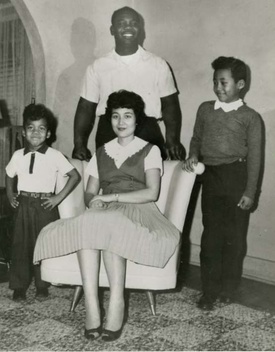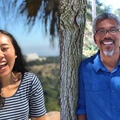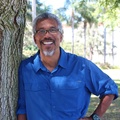My mother was Japanese. My father was Black (African American). My father was Black. My mother was Japanese. I am Black. I am Japanese. I am both. I am Japanese. I am Black. I am both.
Born during the post-WWII occupation and establishment of an ongoing U.S. military presence in Japan, my existence, and hence my “mixedness,” exists in the conflicting nexus of human interaction and government policy as both the U.S. and Japan eschewed interracial relationships, particularly among non-commissioned officers and enlisted men. But, human nature prevailed over policy, resulting in more than 50,000 marriages between U.S. military men and Japanese women between 1947 and 1965. And, so I was born into a bilingual, bi-national interracial black and Japanese family.
U.S. military policy stationed servicemen returning to the U.S. with military (war) brides and interracial families in clusters at six primary military locations, including Fort Riley, Kansas, where my family landed. As a result, I grew up in a military environment with other families that looked like mine—Japanese and Black—along with other variations of interracial and international mixing. As children, we saw parents who were the same color and parents who were not. We spoke and heard languages other than English. We ate foods from all over the world, and in our kitchens created fusion culinary delights. In this way, throughout my childhood and youth I never imagined myself as a unicorn or, as one of my students once put it, “a walking issue.” In many respects, in this military family cocoon we viewed ourselves and our families as just another type of normal.
Don’t get me wrong, we also faced more than our share of taunts along with other forms of discrimination and alienation, much of it mean and nasty, but I never felt alone. Even if we, the children of interracial families rarely actively talked about it—our mixedness—we knew others shared “it,” that others “got it.” While stationed with my family on Okinawa in the late 1960s, my junior high friends and I were engaging in fledgling, adolescent political discussions when the conversation turned to communities of color self-naming and re-appropriating language, like Afro-American. During our musing I commented that, being mixed, I wondered what name fit me, “What was I?” Without missing a beat, a Japanese American friend from Hawaii said, “I know what you are, you’re Hapa-Afro.” He told me that “Hapa” referred to mixed race Japanese in Hawaii. In that moment it all made sense, questions about my identity as a mixed/multiracial person coalesced. It fit. I had a name and with that, I began to understand another important truth: I learned not to own other people’s spite. Still, this lesson was often hard to hang on to and sometimes the noise would drown it out because outside our cocoon, life was a vastly different matter.
Viewed through the societal tropes of either tragic mulatto and hybrid vigor (i.e., best of both worlds) persons of mixed/multiracial heritage bounced between invisibility to hyper-recognition. As tragic mulatto figures we existed as the living cautionary tale against interracial coupling and marriage. Torn between two worlds, unaccepted by either. Destined to a pathological life of internalized turmoil. Even as social mores relaxed a bit and Loving v. Virginia (1967) rendered anti-miscegenation laws unconstitutional, parents, teachers, pastors and others expressed in a kinder, gentler refrain for constraint given to young interracial couples during this period pleaded, “What about the children?”
At the turn of the 21st century, the hybrid vigor social narrative took root. Deemed the “best of both worlds,” the mixed/multiracial subject projected the future, before the future arrived. We were the living evidence of a post-racial society. The imagined post-racial America recast us from tragic hybrid degeneration to hybrid vigor, a siren hope for racial harmony.
As with all tropes and master narratives, nuance and complexity robs people of their subjectivity, their humanity. Today’s college students, born into these actively competing narratives, find themselves trapped in the spite and hope of others.
Throughout the 1980s and ’90s, I spoke widely on “mixedness” to student affairs, academic and public audiences. As a result, I was asked to develop and teach—what was then among the first courses in the discipline of Asian American Studies—a class that was devoted entirely to the question of mixed/multiracial experience(s). It was exciting. Invigorating. Scary. Undergraduates and graduates registered for the course and together we examined not only questions of mixed/multiracial identity and histories, but also the wider “so what?” What would the study of mixed/multiracialness contribute to wider discussions of the roles and epistemology of critical race, ethnicity and culture in social, political and economic explanation? What would the study of mixed/multiracial persons contribute to our wider understanding of biology, physiology and medical practices?
Much has changed since that first course, including the emergence of a robust multi-disciplinary literature on critical mixed race ranging from racial equity, intersectional justice, ethnic and gender identity to bone marrow matches for blood-borne diseases and medication dosages. But, in the nearly 25 years since teaching that first class on multiraciality, in every offering students of multiracial and multiethnic heritage have echoed a version this refrain, “I didn’t know that there were studies about ‘people like me.’” They comment on how empowered the feel knowing that they are not alone. That how reading and seeing stories (scholarly, fiction, popular) about themselves, because they rarely had that chance before, let them know they were not crazy. That their experiences are real and shared. That, importantly they learn a vocabulary, a language to research, talk and reflect upon their life experiences not compartmentalized within the larger story of … (fill in the blank). For the mono-racial students in these classes they remark first that they never knew or thought about how master narratives and tropes constricted their understanding of others’ experiences. Both groups recognize the need to challenge critically what we know and how we learned it.
Notions of self-care embrace concepts like mindfulness and intentionality. Understanding one’s self, being comfortable with the complexities and intersectionalities that comprise us—that make up our skin—is paramount in that self-care. But, so too is community.
Through the 1990s, the Japan American community challenged by the presence of military and international families, long with a fifty percent plus “native” out marriage rate since the 1970s, struggled to understand and embrace these interracial families and their multiracial children. Some lamented the loss of purity, while others feared the loss of a “people” declaring that these “mixed” children were somehow less Japanese/Japanese American and less committed to the “community.” Still others saw this out marriage, particularly to Whites, as a sign of progress or “American acceptance.” Throughout this time period folks of Japanese mixed heritage endured alienation, as well as adoration (particularly in the late 1980s and 1990s). Painful: were we the problem? Confusing: where do we fit? Hopeful: But at what cost?
The national Japanese American community conference “Ties that Bind” that took place in Los Angeles in 1998 sought to unite people of Japanese ancestry in the US, drawing on what we held in common, rather than focus on our differences. In doing so, the Japanese American community acknowledged and embraced its diversity of generation, sexuality, nationality and multiraciality, to name a few. Ties That Bind initiated a community conversation that recognized that mixed heritage Japanese Americans did not exist only on the margins of the community, but were integrated and integral in its future.
In response, the Japanese American National Museum has hosted a series of events and exhibits exploring multiracial identity. Led, by two landmark exhibits by Kip Fulbeck featuring the multiracial subject entitled, part asian, 100% hapa in 2006 and hapa.me – 15 years of the hapa project in 2018, these exhibits gave face and voice to multiracial Asian and Japanese Americans allowing them to speak for themselves. Scores of interracial families visited the museum allowing their children to see folks—young and old—who “look like them” (and not). In more intimate discussion, in 2008 JANM sponsored “Exploring the Realities of Hapa-ness,” a roundtable by multiracial Japanese American scholars discussing family, community and identity. Local Japanese American community centers, churches, sports leagues and organizations created forums honoring our families’ voices engaging in discussion, learning and transformation of community.
Earlier in this essay, I shared a portion of my mixed story and the importance of family and community in living mixedness as another form of normal. While I recognize that my story is not representative of all mixed heritage persons, and may even be exceptional, I know that without the moment of naming—Hapa-Afro—my understanding of self would be very different.
My mother was Japanese. I am Japanese. My father was Black. I am Black. I am Japanese and Black. I am one. I am the other. I am both. (And, so much more …)
* This article was originally written for LMU This Week on May 22, 2020 and edited for Discover Nikkei.
© 2020 Curtiss Takada Rooks






